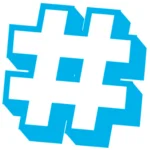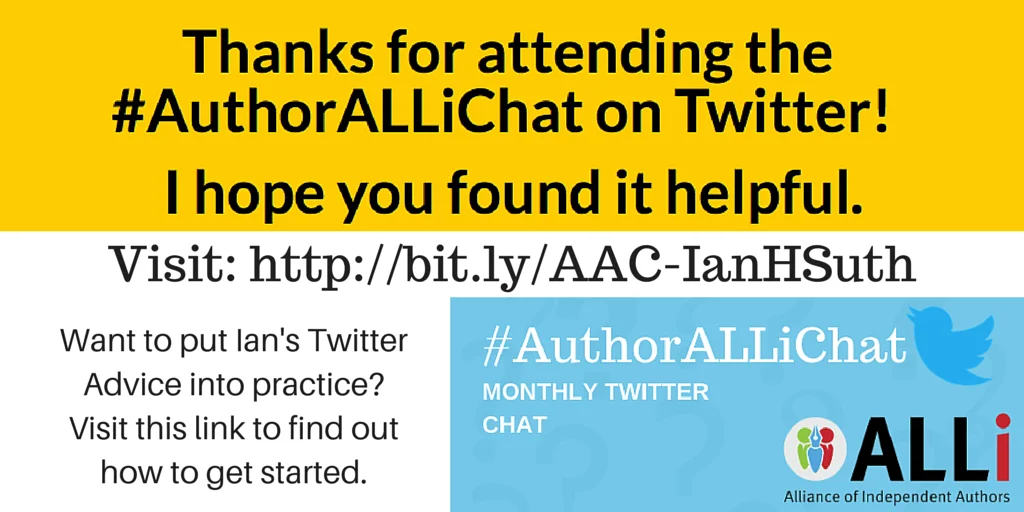Ian Sutherland's keyboard was on fire Tuesday as he fielded questions at our August #AuthorALLiChat. The Topic of conversation was how his Twitter following has grown to 40k, and he gave tips on how other authors can promote their books on Twitter without being sleazy self-promotion hounds.
This is all part of our monthly Twitter Chat series with self-publishing industry subject matter experts, and below is a summary of the key takeaways from the chat with Ian.
Twitter Strategies for Authors
What piqued our interest in your book @IanHSuth was the focus on your #SHARP strategies … here's how Ian describes them:
SHARP came about because I needed to articulate the principles I abide by as an #author on Twitter. Ian
SHARP defines five behaviours for successful Twitter engagement: Systematic, Helpful, Active, Relevant and Personable.
- Active means tweeting and RTing. LOTS! Studies show the more you tweet the more followers you have
- Relevant means tweeting lots of good, fresh content to your followers, congruent with your books’ themes or subjects
- Personable is the most important. It just means be yourself. Engage with people in conversation. Don’t just promote!
The point of all this is that if you follow the SHARP principles, you are adding lots of value to your followers, which means you then have a earned the right to do some book promotion in moderation. 80:20 or 90:10.
It's like a license to sell. (I hope Ian Fleming would approve)! Ian
It’s important to have these SHARP principles because Ian recommends a bunch of automated tools to help keep your Twitter activity down to 15 minutes per day.
Left unchecked, using automated tools turns can turn you into nothing more than a robot which is not good. That's why implementing a SHARP approach is so important.
What content should Authors Tweet?
 Ian recommends tweeting on lots of different topics around your book's theme or subjects, but one of the secrets to tweeting good, fresh content is RSS feeds.
Ian recommends tweeting on lots of different topics around your book's theme or subjects, but one of the secrets to tweeting good, fresh content is RSS feeds.
When you subscribe to RSS feeds from relevant websites in your book's theme or genre, it's a never ending supply of content
What Twitter Automation Tools should Authors use?
Using a tool like SocialOomph, allows you to automate the conversion of new posts into tweets, with no additional effort.
Ian reviewed lots of applications to schedule tweets, including Hootsuite and Buffer, but found them too limiting.
- Hootsuite requires you to schedule tweets at specific times, and although you can bulk upload from Excel it's a cumbersome process.
- Buffer has the same “queue” concept as Social Oomph, and you can add tweets to a queue that drip-feed out to Twitter. But Buffer only has one queue and Ian wanted more flexibility to control when Tweets drip feed into his stream so he opted for Social Oomph to automate his Twitter stream.
What Other Tools are available to Authors?
- Use a link shortener to for all his links: bit.ly. It presents your tweets in a much better way and also provides you with analytics.
- An app called RoundTeam can automate Retweeting, by sourcing content based on keywords or hashtags. (Retweeting is one area that you need to monitor closely, to ensure you're not retweeting spam. The key thing to focus on is that you're mostly tweeting value added content with a little bit of book promotion on the side.)
- Use Twitter Lists (and columns in TweetDeck) to filter on people you really want to stay close to on Twitter
I remain personable (despite so many followers) by using TweetDeck to track any @mentions. Then I reply personably. Always! Ian
What are some of the popular Hashtags to use in your Tweets?
 Here's a selection of hashtags that are used by the Indie Author and self-publishing community:
Here's a selection of hashtags that are used by the Indie Author and self-publishing community:
- #IARTG (Indie Author Retweet Twitter Guide)
- #ASMSG (Authors Social Media Support Group)
- #IAN1 (Independent Author Network)
- #BYNR (Be your next read)
If you come across a hashtag you're not sure of, you can check it's definition on a site like www.tagdef.com.
Some other useful hashtags:
- #writing
- #notwriting
- #amwriting
- #author
The reason these hashtags are important is because many other authors will RT you, improving your reach exponentially.
Is there any value in using two separate Twitter profiles?
This is an interesting dilemma for an author. Should you have one account for personal tweets and one for your author profile? Here's what Ian had to say:
Yes and no! No, because it's a nightmare to maintain. I know because I have two! Yes because I target two different audiences, and what I tweet to each is very different.
Following and Unfollowing Strategy
If you do all the added value activities in Twitter, you will attract new followers without implementing an active follow/unfollow strategy.
But if you want to influence people to buy books, you need lots more followers. The more followers you have, the greater your reach.
At the end of the day, Twitter (as a tool for book promotion) has to be a numbers game. The logic is that many people follow back people who follow them within a few days. Therefore, if you follow more people, you gain more followers. A necessary evil on top of the nice organic strategies. Ian
When you get to 40,000 followers, your tweets really do have more reach and influence — as long as you don't just promote your books. (Back to SHARP)
What's Ian's biggest learning from using his Twitter Strategies?
With how quickly our world and technology evolves, I was interested to learn what Ian's biggest learning was since working his strategies, here's what he had to say:
When I wrote it I said the P in SHARP was the most important. And it's proven true. Be Personable. Ian
Which shouldn't be too much of a surprise to use. After all, it's “Social” Media, and if you lose sight of this pivotal aspect of your activity … you're just broadcasting and not engaging.
How do I implement my own Twitter Strategy for Authors?
Ian recorded a series of 10 free instructional videos that explains the key concepts of his Twitter Strategy approach.
Here's the link to sign up for his video series, and a generous promo offer for his Advanced Twitter Strategies for Authors book
ALLi's Twitter Chat Guest Speaker
 Ian Sutherland is and Indie Author who self-published his first book “Invasion of Privacy” in August, 2014. On the same day he published a prequel novella, entitled “Social Engineer”, on the same day. Both books pull from Ian's extensive IT experience, and have our modern-day dependence on technology front and centre.
Ian Sutherland is and Indie Author who self-published his first book “Invasion of Privacy” in August, 2014. On the same day he published a prequel novella, entitled “Social Engineer”, on the same day. Both books pull from Ian's extensive IT experience, and have our modern-day dependence on technology front and centre.- As an indie author, Ian focused on all aspects of writing, publishing and marketing his fiction thrillers. As part of this, Ian developed and adopted a wide range of strategies to help readers discover his books. In particular, Ian found Twitter to be one of the best social media platforms to market and sell his books. But, you can’t just spam your Twitter followers to death! So Ian developed a set of advanced techniques to help authors sell more books. He reveals his secrets in his new non-fiction book “Advanced Twitter Strategies for Authors“.
- Twitter Chat Date: 11th August 2015 8pm London
- Follow Ian Sutherland on Twitter at: @IanHSuth and @iansuth (his author profile)
Join our next Twitter chat
- You can join in our Twitter Chats by using hashtag: #AuthorALLiChat
- Twitter Chat facilitated via: @IndieAuthorALLI
- Participate directly on Twitter OR join in via Twubs: http://twubs.com/
AuthorALLiChat - If you haven't used Twubs before, it's a lot more user friendly that trying to follow the conversation directly in Twitter, and it allows you to set the speed of the feed according to your preference and you can also hide any retweets.








[…] Twitter Strategy Chat with Ian Sutherland (our August #AuthorALLiChat) […]
[…] Recap of last month’s #AuthorALLiChat with Ian Sutherland, where we chatted about “How to use his… […]
Greetings all! Sorry I missed this one – I am a fan of Mr. Sutherland’s SHARP strategy and in fact RT his post about why authors should avoid using that annoying TrueTwit just this past week. Here’s my question: in this article it mentions Hootsuite is ‘too limiting’ because it ‘requires you to schedule tweets at specific times’. Well, I suppose it does, but it does offer a way to automate the process via its Autoschedule feature. I don’t have to ponder on which date and time to schedule each and every tweet. I just select an article or tweet to tweet or RT, click on the Autoschedule feature, and Hootsuite plugs it into my schedule somewhere. I still look over each day’s tweets, but I find the Autoschedule feature very useful. What am I missing that I could be doing better if I used another service?
Great insights, with a focus on developing an effective Twitter presence that takes just a few minutes’ maintenance each day. Nice work, Ian. Reading the book now.